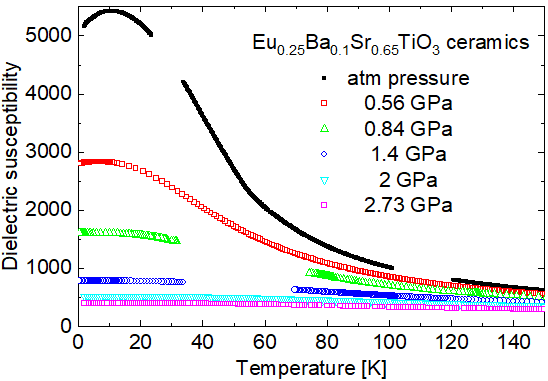
Multiferroic quantum criticality in (Eu,Ba,Sr)TiO3 system
2Department of Solid State Engineering, Faculty of Nuclear Sciences and Physical Engineering, Czech Technical University in Prague, Prague, Czech Republic
3Department of Condensed Matter Physics, Faculty of Mathematics and Physics, Charles University, Prague, Czech Republic
4Department of Advanced Multifunctional Ceramics, CEITEC - Central European Institute of Technology, Brno, Czech Republic
The existence of multiferroic quantum criticality was theoretically predicted in (Eu,Ba,Sr)TiO3 solid solution.1 Since pure BaTiO3 is a ferroelectric (below ≈ 400 K), SrTiO3 is a quantum paraelectric, and incipient ferroelectric EuTiO3 is an antiferromagnet below ≈ 5 K, the Eu0.3Ba0.1Sr0.6TiO3 should exhibit both magnetic and ferroelectric quantum criticality1, and consequently an unconventional low-temperature scaling (power dependence) of its physical properties (e.g. electric and magnetic susceptibility).
Within our research, (Eu,Ba,Sr)TiO3 ceramics, as well as a single crystal, with compositions close to the Eu0.3Ba0.1Sr0.6TiO3, were prepared. All samples were examined in terms of low-frequency dielectric permittivity, magnetization, magnetic susceptibility and heat capacity in temperature range 0.3-300 K. Since the phase transition temperature generally depends on many physical conditions, the samples were studied in an external electric field of ≈ 2.5 kV/cm, magnetic field of up to ≈ 10 T and hydrostatic pressure of up to 2.73 GPa (see Fig.).
The temperature dependence of dielectric permittivity shows the presence of ferroelectric quantum criticality (as quantum paraelectrics SrTiO3 or KTaO3). Reciprocal magnetic susceptibility, however, follows a linear Curie-Weiss dependence (at least down to 2 K) with antiferromagnetic Curie temperature of ≈ 0.8 K. At similar temperature (0.7 K), a peak in magnetization occurs, which corresponds to the antiferromagnetic phase transition. In fact, its temperature also coincides with a Schottky anomaly existing on Eu2+ magnetic ions which was revealed by the heat capacity measurement performed at various external magnetic fields.
1Narayan, A., et al. Nature Mater. 18, 223 (2019).

Fig.: Temperature dependence of dielectric permittivity of Eu0.25Ba0.1Sr0.65TiO3 ceramics measured at various hydrostatic pressures.
Powered by Eventact EMS
